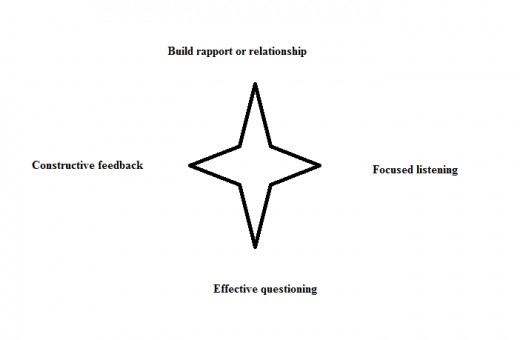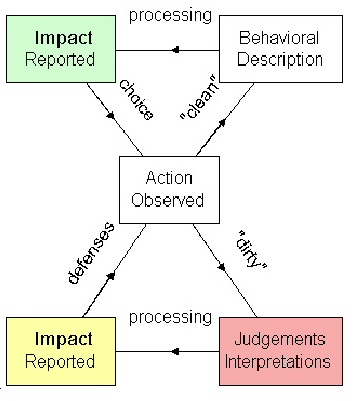Communication Strategies and Tools for Coaches

Communication Strategies and Tools for Coaches.
Enjoy article 2/5 in the series on Coaching.
The Knowledge, Skills and Behaviors of an Effective Coach and Mentor.
Build rapport or relationship
If you want to influence someone constructively, without dictating to them, rapport is essential. Rapport is built on features of sameness, and poor rapport normally indicates feelings of detachment or difference. By increasing your ability to relate to others on their own terms, you improve your ability for rapport and therefore influence.
Focused listening
For any manager and coach, focused listening is a valuable skill to develop. When we listen properly to someone, we can increase their ability to express themselves. What stops us from listening in any situation is simply ourselves. Either we are distracted by our own thoughts or ideas, or we simply don’t make the effort to focus on someone else. Really good listening demands that we make the other person more important in the conversation and ‘let go’ of the importance of ourselves. As we really focus on someone else with the intention of listening fully to them, the sense of ourselves, our ego, diminishes.
Effective questioning
Effective questions are worded so that the person answering only needs to work on forming their response, rather than their understanding of the question. Effective questions also have a clear sense of purpose, for example, to gather more information, see something from another perspective, or create a sense of the future. Some useful examples of coaching questions follow, and note that they are open in intention and not restricted by an anticipated answer.
A handy list of effective questions and coaching examples:
Questions with a clear sense of purpose:
Purpose
Coaching examples
Gather general information.
Can you say more about that?
Gather specific information.
Specifically, what is it that you’re unhappy about?
Can you tell me what actually happened?
Help someone remember something more clearly.
What else can you remember?
To refocus someone on what’s important, for example, keep them on track, or calm them down etc.
Ok, so what’s really important about all this?
What seems to be the most important thing for us to focus on now?
Understand someone else’s values.
What is important to you about that?
Why is that important to you?
Help someone appreciate another person’s perspective.
What might be John’s reasons behind asking for this?
What’s important to John?
If we had John here – how would he describe this situation?
Get someone to link two thoughts, or situations, together.
How do your work pressures relate to what you said about developing the team more?
Help someone come to a conclusion.
What are your thoughts about this now?
What is the conclusion you are drawing from this now?
Produce ideas without a sense of pressure.
What options are there?
What options are available to you?
What things might you do?
What ideas are you having?
Influence someone to decide.
What option do you prefer?
What have you decided to do?
Influence someone to action.
What could you do about that right now?
Prepare someone to overcome barriers to taking action.
What might stop you from doing that? [Follow-up] So how will you overcome that?
Strategized question
Question with a more open intention
Couldn’t you speak to your boss about this?
What support do you need with this?
Have you considered putting a plan together to make everyone agree to the dates?
How can you get everyone to agree to the dates?
How angry are you about all this?
How are you feeling about this?
What could your HR representative do to help you?
Who else might help?
[Or even more open] What are you thinking of doing?
Didn’t you say that Michelle doesn’t actually want to be involved anyway?
How would Michelle feel about that?
A powerful question:
· Acknowledges the issue or challenge;
· Assumes that a positive outcome is possible;
· Is open (what, how, when, who, why) and provokes a creative response.
Statement of issue/complaint
Powerful question
It’s hopeless – we’re never going to get it done by Friday because we’ve already got so much other work in the queue.
How can we get it done by Friday and still deal with the other work in the queue.
We’d love to have a staff summer party again, but the money needs to go on training this year.
How can we find the money for a summer party and still afford the training?
We really need to do some team collaboration, but people’s roles are going to change and we don’t yet know what that’s going to mean.
How can we do some team building and still support the new roles in the future?
Portfolio Piece for Coaches
Discuss/Write/Reflect
1.Try out at least one of each questioning style on your coachee and document how the response leads to their empowerment or solution to the issue they are discussing in a session with you.
2. If coaching a group, evaluate the success of one of the questioning methods above.
Constructive feedback
Most of us would choose to receive constructive feedback – which supports our ability to learn, develop and be successful – on a regular basis. So giving constructive, motivating feedback becomes a necessary tool for any effective manager. The challenge is to offer these messages using a balanced, natural style, so that people can welcome and engage with them. Where this applies to a coaching type of manager, is prioritizing the attitude that the development of others is important. Objective feedback as opposed to subjective feedback is the right style. Behavior-based language is the right expression.
1. You describe the behaviors and actions of the employee/coachee—what they did.
As the term “behavior-based language” implies, this is the act of describing the observed behaviors of an employee/coachee. This is when coaching is challenging and behaviour language will help you raise issues without sounding aggressive. Here are some examples:
“You arrived late this morning.”
“Your report missed some elements.”
“You skipped a step in following the procedure.”
“You said, ‘I hate you’ to the customer.”
“You threw garbage into the hallway.”
“You smiled and used eye-contact with all in the room when you first started your presentation.”
This is not necessarily easy, because it is easy to forget what the behaviors were. The mind tends to want to speed past and gloss over the observation and generalise and evaluate the observed actions and behavior. It is important to start with what it was that the person did. This can be used when discussing with your coachee other people they deal with also, as a neutral way of beginning a conversation and getting your coachee to open up.
2. You have specifics about what someone did and said and at what time.
Generally the more specific the better. Try to phrase things to cite the specific incident you’re thinking of.
“At the meeting this afternoon, I saw you put your head down on the table.”
“I learned this that this morning you spoke in a forceful tone to a client.”
“I heard you say, ‘I don’t care what you think.’”
“You said that this was something that can be resolved.”
The closer you can come to quoting incidents, the better, although this is difficult too. If you don’t have the specific quote at hand, you can use, “You said that,” or “You said something to the effect of. . .” This helps a coachee ‘own’ the problem.
3. You attempt to quantify the frequency of the behaviors.
“On three occasions, we have reports of you yelling at customers.”
“Two times in the last week your code broke the build.”
“I’ve heard you say ‘I can’t help you’ three times in the last month.”
“You’ve had the presentation set up and ready to go in advance of the meeting for each pitch meeting this month.”
The reason quantification helps you be more behavior-based is that this identifies whether the behaviors are actually repeated or one-time. If someone does something only once, then this isn’t necessarily indicative of their ongoing behavior. If you can cite a behavior that was observed multiple times, then it is more worthy of discussion – as it is a pattern.
4. You start the sentence with, “What I have observed is”, “Others have observed” and “What I heard”.
Starting qualifiers of “what I observed” and “what you said” and “what I heard” will help guide you to language that is more behavior-based.
“I heard you say, ‘I plan to slack off work next week.’”
“I observed that you came in late in each of the past three days.”
“I saw that you were setting up the presentation in advance.”
“I observe that your program has not helped the project all month.”
If you can’t start the sentence with “What I heard was. . .” “What I observed was. . .“ “What others observed was. . .”, and have it still makes sense in your mind, then it is less likely to be behavior-based.
Be aware that feedback laced with judgements and interpretations is less well received than feedback that is behaviorally specific.
For information on how to launch a coaching product or service on your website check out this excellent Kindle Download.
Clean versus Dirty Feedback Model

Portfolio Piece for Coaches
For your coaching portfolio: Before you see a coachee/employee ...
Discuss/Write/Reflect
Think of an example of feedback you would like to give, and practice phrasing this objectively and with behavior-based language. After, write down how well the feedback was received and if your coachee made progress.
The next article in this five part mini-series about Coaching and professional coaching is called Coaching for Organizational Change and covers organizational barriers to coaching within organizations and individuals, and what you as a coach can do about them.








